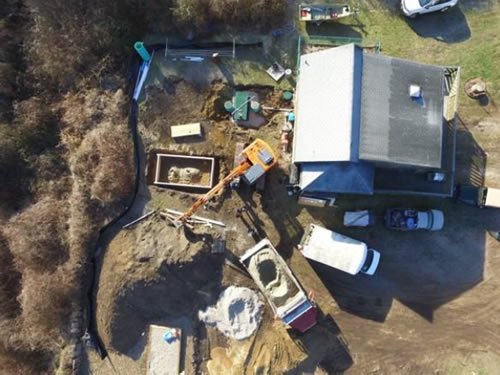A Pound of Prevention: Stopping Nitrogen at the Source with Advanced Septic Systems
April 2020

Septic systems work by slowly infiltrating waste through the soil and ultimately into groundwater. Well- managed conventional systems are good at removing bacteria from wastewater effluent, but not effective in removing the nitrogen that is a component of the wastewater. So, our sources of drinking water and surface waters can be vulnerable to two problems: inadequate treatment of human waste from poorly functioning septic systems causing inadequate treatment of pathogens, and inadequate removal of nitrogen to maintain drinking water quality and support ecological health. Release of pathogens from septic systems may pose a health risk for people using nearby private wells for their drinking water, and may also contribute to shellfish closures and beach closures. Release of nitrogen from conventional septic systems may lead to unsafe concentrations in drinking water and may cause severe water quality problems such as algae blooms, loss of eelgrass and low dissolved oxygen levels. Fortunately, there are scientists hard at work on new septic systems that not only treat the bacteria in wastewater but also reduce the nitrogen entering our watersheds, streams, and embayments.
The SNEP-funded Charlestown Coastal Watershed Protection and Restoration Program works to improve water quality in southeast coastal Rhode Island. The goal is to fund the upgrade of septic systems to incorporate Nitrogen-reducing technology—in short, getting the waste out of wastewater. The group works to limit human impacts on the rest of the environment because those ecologies matter to human health and livelihoods. The first step in that direction was a model predicting Nitrogen concentrations from septic effluent. Their findings include that some 80% of the nitrogen in Charlestown's waters comes from septic systems in densely developed areas. The total contamination is in excess of public health standards.
The Town of Charlestown partnered with researchers at the University of Rhode Island to develop the protection and restoration program. Charlestown has been a leader in municipal action on septic issues, in part out of necessity—there is no sewer system—and because the town's economy is closely linked to its coastal ecology, with town income dependent on a seasonal home tax base and tourism revenues. The town is suitably home to the state's first onsite wastewater management program and so had the capacity to engage in septic improvement work.
The researchers used GIS to identify septic systems that were contributing to the most sensitive ecologies—the salt ponds within the watershed, which experience eutrophication and hypoxic events with near annual regularity. A competitive application process followed in 2018 that saw over 220 systems tested, and fifteen of the worst offenders in the most sensitive zones targeted for upgrades. To defray the cost of the upgrades, landowners were awarded up to $18,000, or 75% of the upgrade cost, whichever came first. Owners were responsible for soliciting at least three quotes from contractors as well and had to commit to finish work within a year of their award. These requirements were a purposeful effort to garner investment from owners, not just in financial terms, but to promote trust, raise awareness, and facilitate understanding of the process.
The researchers also tested the technologies that could be used to reduce nitrogen and found that the upgrades would be expected to cut Nitrogen contributions from septic systems at least in half. Originally, 150 lbs./year of Nitrogen were projected to be removed by upgrades to just these fifteen systems. A later analysis that accounted for more variables more than doubled expectations to 357 lbs./year. That meant that tons, literally tons of Nitrogen will not enter Charlestown's vulnerable coastal systems as a result of the improvements.
Having installed the final upgrades last year, the program has completed construction and is set to begin tracking results. The researchers have developed cost-effective monitoring to ensure that the new systems are functioning as expected, a process that used to be lengthy and costly. Monitoring will begin this year.
Considerable progress has been made in limiting the Nitrogen contributions from homes that benefitted from the program. The positive reception even has the town's public works department thinking about overlay districts for septic regulation. Public perception of their approach is becoming more favorable, too, through the program's own education and outreach efforts, which included interfacing with a sizeable part of Charlestown's population and a professional-grade video documentary series. But the benefits do not stop at the Charlestown borders. The lessons learned are transferrable to other municipalities and another chapter of the project is planned to repeat the effort elsewhere with even better and less expensive technology. The researchers hope that the results will sway regulators to lower the allowable Nitrogen contribution from septic systems and make the innovative/alternative option standard.
For more information on the project contact Matt Dowling ([email protected]).
